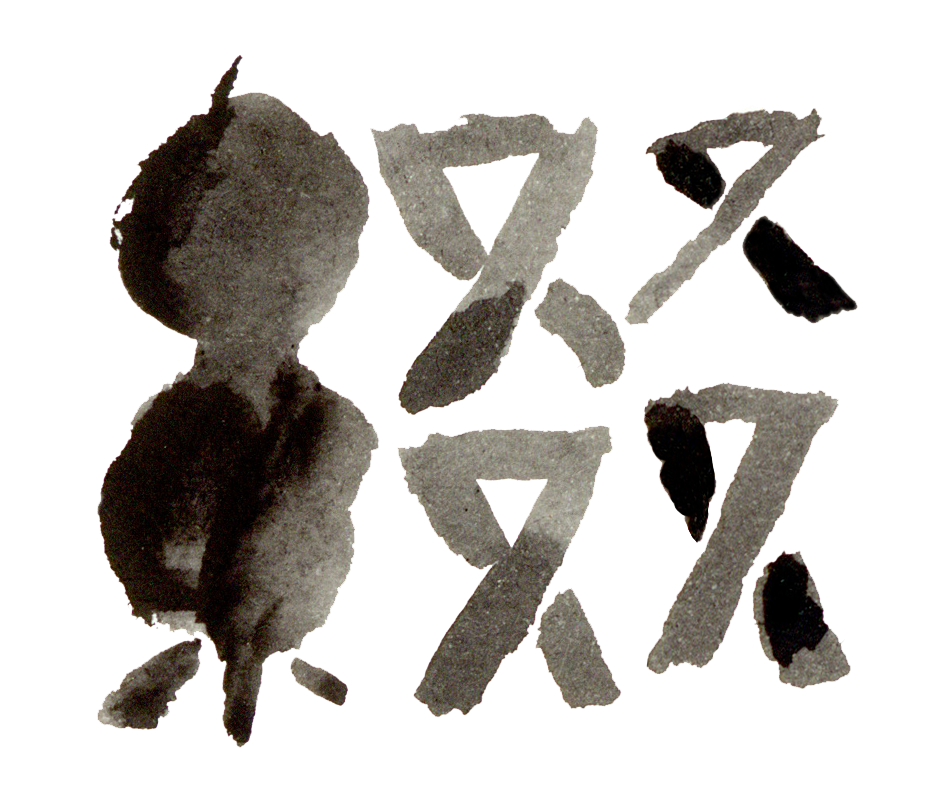ARCHIVES
2025.02.21
レジデンスアーティスト マーガレット・ウィブマー「Salon d'Amour」に寄せて
2024年秋に「綴る」が招聘したレジデンスアーティストとしてイクヤマ家に滞在し、展覧会「消えつつ 生まれつつ あるところ」に参加したマーガレット・ウィブマー(1959-)のパフォーマンス「Salon d’Amour」について、本展キュレーター清水冴がレビュー
マーガレット・ウィブマー(Margret Wibmer,1959-)は、洋裁師の母親の影響からテキスタイルに関心を持ち始め、パフォーマンス、写真、映像、オブジェなど様々なメディアを扱い、ファッションとアートの境界線上で作品を手掛けてきた。1980 年代のニューヨークでは、親類にあたるアーティスト・宮本和子(1942-)とともに、ジョン・ウェーバー・ギャラリーでミニマルアートを代表するソル・ルウィット(1928-2007)のアシスタントを務め、1990 年に出産を機にアムステルダムへ移住して以来、同地を拠点に活動している。マーガレットが 2016 年から継続している「Salon d'Amour」(愛のサロン)は、著名な作家や学者が恋人や友人に宛てた手紙や詩を朗読して聞かせる参加型のパフォーマンスである。会場にはアメリカ在住のサウンド・アーティスト、ロバート・ポスが作曲した神秘的な音楽が流れる。参加者は二人一組となり、一人はテキスト(Manuscript)を朗読する。もう一人はマーガレットが制作したユニークな仮面(Mask)を被り、視界が閉ざされた状態で、相手の声に耳を傾ける。音楽と参加者たちの朗読する声が空間に木霊する。
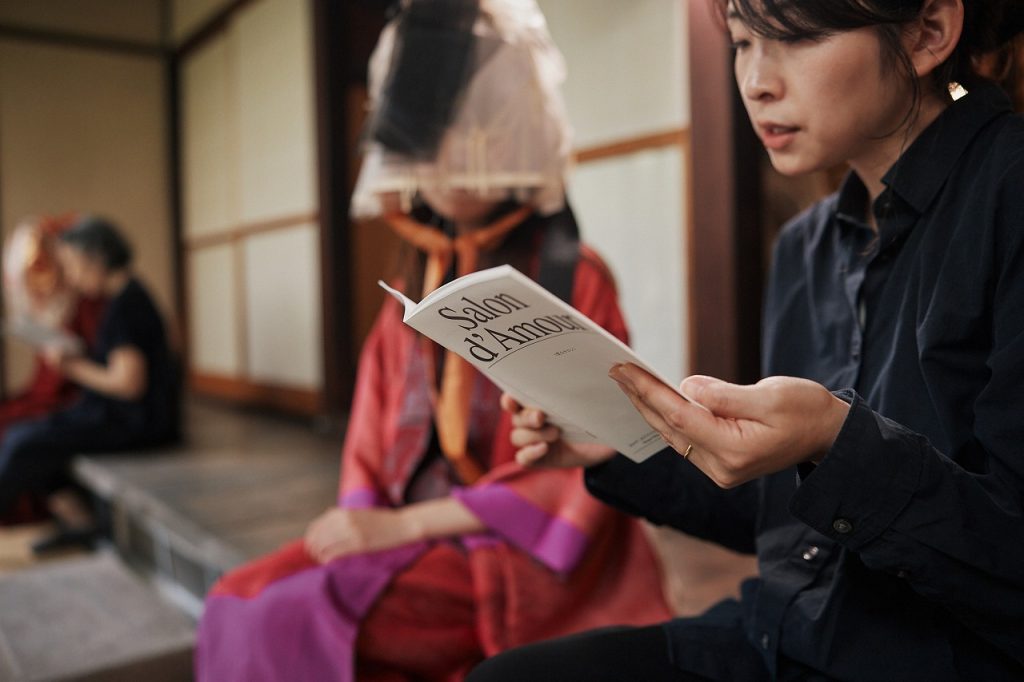
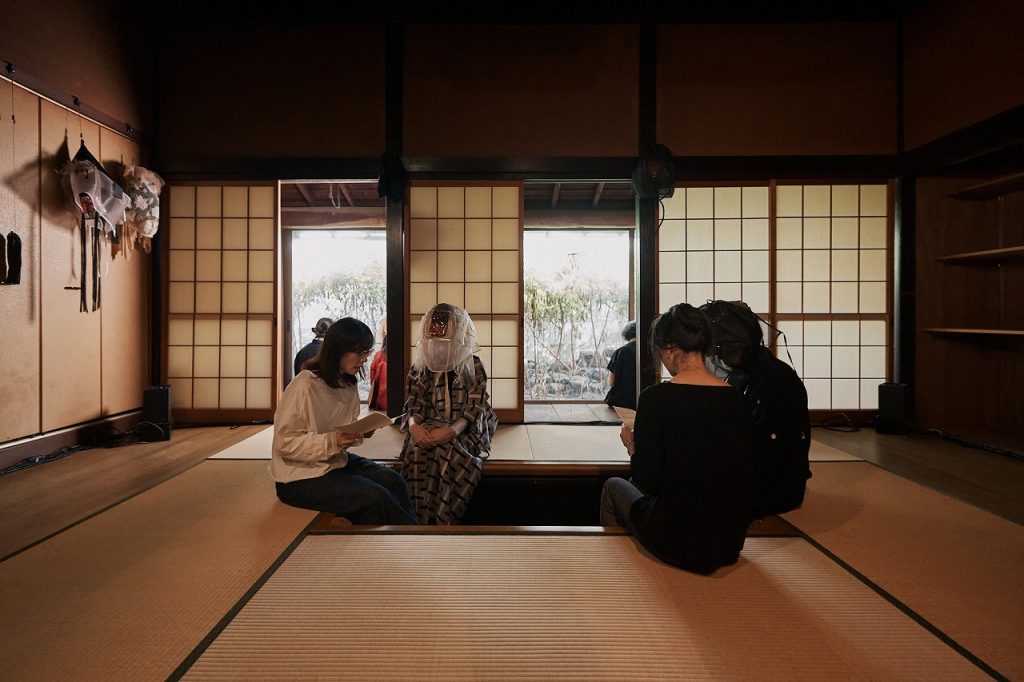
Margret Wibmer Salon d'Amour (2024) Photo by Nik van der Giesen
レジデンス・アーティストとして、マーガレットは20年来のパートナーのルーと来日した。興味深いことに、彼は初めて菊川の街や空き家を見たとき、そこに何かの気配を感じたという。それらはネガティブなものではなく、好奇心旺盛な観察者、霊魂、エネルギーであり、純粋に私たちの動きに関心を持っているだけなのだという。「Salon d'Amour」が行われたのは、私たちが「お向かいの家」と呼ぶ、築 100年を超えるこの地域で最も大きな日本家屋で、かつては武家屋敷として使われていた空き家である。ルーはパフォーマンスが彼らに対する一種の挨拶として機能しているようだとも言った。日本には「地鎮祭」と呼ばれる伝統的な建築儀礼があり、土地を清め、神々に守護を祈るために行われる。地鎮祭は更地にのみ行われ、既存の建物には行われないが、お向かいの家は次の所有者によってホテルに改築される運命にあり、その中で「Salon d'Amour」は芸術表現を通じて、地鎮祭的な役割を果たした。
ある回のパフォーマンスで、ひとりの参加者の指摘によって、「Salon d'Amour」が開催されている部屋がまさに「仏間」だと気が付いた。参加者たちが各々テキストを読み上げる声は、静かに仏間に響き渡り、それはお経や、祈りの歌に似ていた。また、「Salon d'Amour」を通じてマーガレットが探求している世代、性別、人種、宗教を超えた「愛」の表現は、仏教の「慈悲」の概念と一致し、本展に影響を与えた仏教的なアイデアと深く共鳴している。そして、マーガレットとルーによって進行されたパフォーマンスは、空き家という状況にある空間を、居心地の良いものへと作り変えた。さらに、現在では消えつつある「ラブレター」というモチーフが、センチメンタルでロマンチックなムードを高めている。1 回の公演に1時間30分ほどの時間を要する「Salon d'Amour」には、会期中に何度も参加し、テキストを読んで涙する参加者がいた。近年、世界中にアートが溢れるなかで、1時間以上も私たちの注意を引きつけ、心を揺さぶるような作品に、私たちはどれくらいの頻度で出会うことができるだろう?
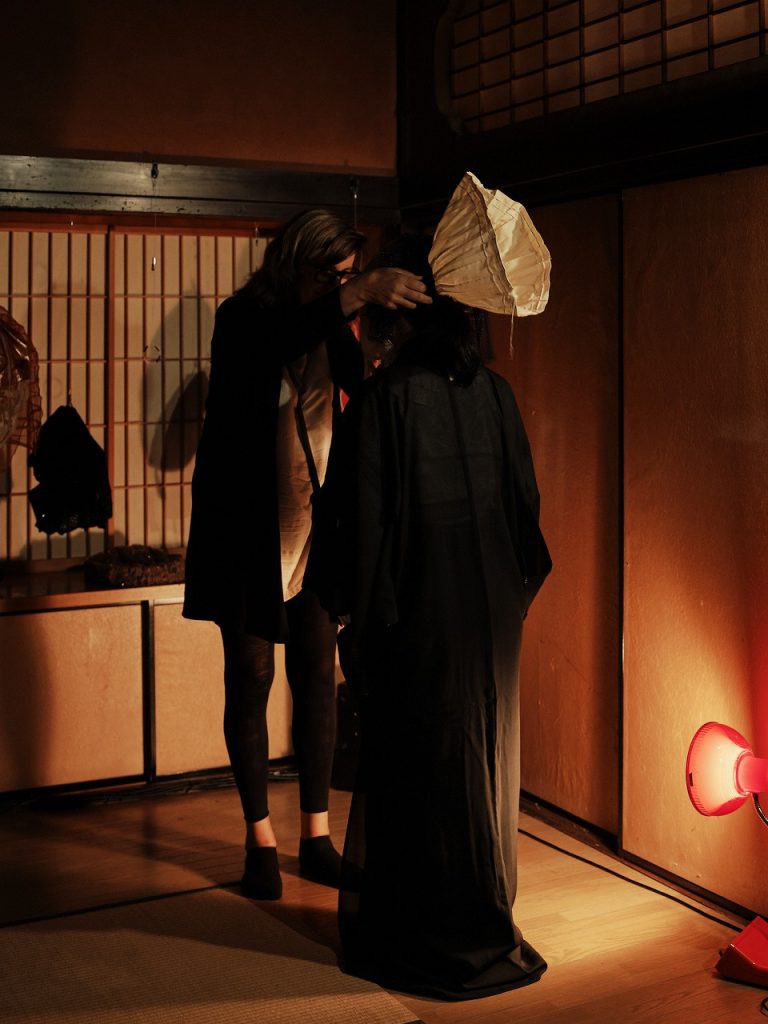
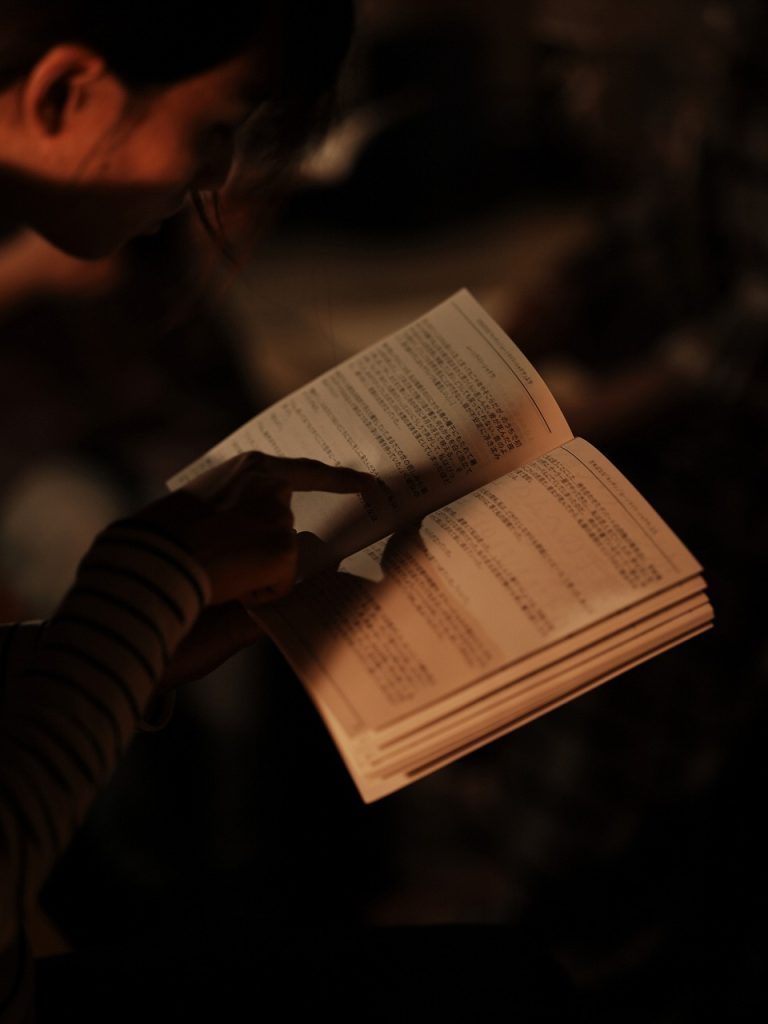
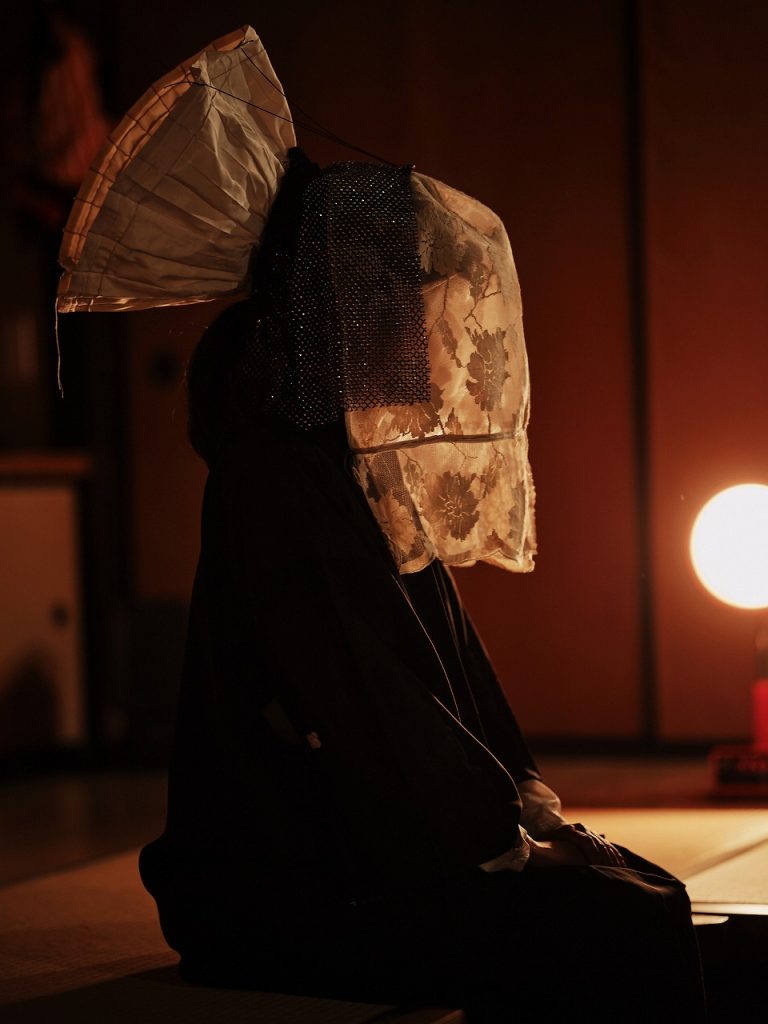
Margret Wibmer Salon d'Amour (2024) Photo by Nik van der Giesen
一方で、「Salon d'Amour」は詩的で形式的なものに留まらず、マーガレットが「ソーシャリー・エンゲイジド・アート(SEA)」の実践として取り組んでいることも明らかである。例えば、テキストにはジェームズ・ボールドウィン(James Baldwin)の小説『もうひとつの国』(Another Country, 1962)からの抜粋が含まれている。マーガレットが選んだのは、黒人男性の主人公がジョージ・ワシントン・ブリッジから飛び降りて自殺する直前のシーンである。彼は生前、自分を深く愛してくれた恋人の白人女性に精神的な負担をかけていた。しかし、黒人としてのアイデンティティに対する内面的な葛藤、自己嫌悪が、白人である恋人やニューヨークの人びとに対する憤りと相まって、最終的に彼を蝕んでいった。言うまでもなくこの物語はマーガレットにとって重要なインスピレーションの源であり、また、このパフォーマンスにおいて、さまざまな種類のテキスタイル、着物の帯、レース、リボンやスパンコールを繊細に縫い合わせて作られた仮面の役割を示唆している。仮面によって性別、人種、年齢といった視覚的な情報は奪われ、参加者は一時的に「誰でもない者」へと変身する。マーガレットは、人間の身体ではなく、魂に宿る「愛」の存在を視覚化する手段として仮面を扱っているのである。
マーガレット・ウィブマー Margret Wibmer
1959年オーストリア・リエンツ生まれ。オランダ・アムステルダム在住。1980年代ニューヨークにて、アーティスト宮本和子とともにソル・ルウィットのアシスタントを務める。日常の素材を用いた写真、パフォーマンス、オブジェの制作を通じ、人間の根源的な感情を探求している。主な作品に、著名な哲学者や文学者などが友人らに充てた手紙を朗読して聞かせる《Salon d’Amour》(愛のサロン)がある。2022年にはジョン・D・ハルパーンとエミリー・M・ハリスが率いるアメリカの「カルチュラル・アクティビズム」に参加し、パフィーマンス作品《スロー・ウォーク》(2022)を共作。いずれも、世界各地で上演している。
https://margretwibmer.eu
On Margret Wibmer’s Salon d’Amour as a Residency Artist
In the fall of 2024, Margret Wibmer(1959-), invited as an artist-in-residence by the NPO “Tsuzuru,” stayed at the Ikuyama-house and participated in the exhibition. Curator Sae Shimizu reviews her performance Salon d’Amour.
Margret Wibmer’s interest in textiles began with her mother, a dressmaker, and she has worked in a variety of media, including performance, photography, video, and objects, navigating the boundary between fashion and art. During the 1980s, in collaboration with Kazuko Miyamoto(1942–), she worked in New York assisting renowned minimalist artist Sol Lewitt(1928–2007). After moving to Amsterdam in 1990 following the birth of her child, she has continued her artistic career there. Since 2016, Margret has been developing Salon d’Amour, a participatory performance in which participants read letters and poems by prominent authors and artists written to their lovers and friends. The performance is accompanied by mystical music composed by American composer Robert Poss. Participants pair up, with one reading a text (Manuscript) aloud while the other wears a unique mask created by Margret, losing their vision and listening attentively to the voice of the reader. The music and voices reverberate throughout the space.
Salon d’Amour was held in an old Japanese house over 100 years old, the largest house in the area, which once served as the residence of a samurai family. Margret stayed in Kikugawa with her partner, Lou. Interestingly, upon seeing the abandoned house for the first time, he sensed a presence there. He did not describe it as a bad or negative energy but as curious observers or spirits, simply interested in our movements. He also remarked that Salon d’Amour seemed to function as a kind of greeting to them. His observation was remarkably accurate. In Japan, there is a traditional ritual called Jichin-sai, performed to purify land and pray to the gods for protection, typically before constructing a new building. However, Jichin-sai is usually conducted only on cleared land, not on existing buildings. Actually, this house is destined to be converted into a hotel by its next owner. In this context, Salon d’Amour served as a form of Jichin-sai, fulfilling a similar role through artistic expression.
Remarkably, though unnoticed until a participant pointed it out, we were in the "Buddha room,". During Salon d’Amour, the voices of participants reading from the “manuscripts” quietly echoed through the Buddha room, resembling the rhythm of a sutra chant or a prayer song. Through Salon d’Amour, Margret explores expressions of "Love"—transcending generations, gender, race, and religion through her performance—which resonated deeply with the essence of the Buddhist concept of “Compassion,” and the themes explored in this exhibition. Salon d’Amour, supported by Lou and facilitated by both Margret and him, created a safe and nurturing atmosphere for participants, even in the context of an abandoned house. Moreover, the already fading medium of love letters in our modern age added a layer of sentimentality and romanticism. The performance, which lasts about an hour and a half, saw participants return multiple times during the exhibition, some even moved to tears during the experience. It made me reflect: in recent years, with art overflowing worldwide, how often do we encounter an artwork that holds our attention for over an hour, or that moves us to tears?
Yet, this performance went beyond the poetic and formal beauty of a ritual—it also becomes clear that Margret is practicing "Socially Engaged Art" (SEA). For example, the “manuscript” includes an excerpt from the novel The Other Country (1962) by James Baldwin. Margret selected a scene involving the main character, a Black man who commits suicide by jumping from the George Washington Bridge. Before his death, he inflicted emotional strain on his lover, a white woman who deeply loved him. However, his internalized struggles with his identity as a Black man, combined with his self-hatred and resentment toward his white lover and the people of New York, ultimately consumed him. This story has been a significant source of inspiration for Margret, and it also suggests the role of masks made by delicately stitching together various types of textiles, kimono sashes, lace, ribbons, and sequins. The mask obscures visual information like gender, race, and age, and temporarily transforms each participant into "nobody." Through the mask, Margret seeks to visualize the presence of "love" within the human soul, rather than in the physical body. Finally, I found Salon d’Amour to be a special situation that included masks, space, time, music, voice, other participants, Margret, and Lou. As an artwork, it successfully maintained the balance necessary to look into our souls very carefully.
Margret Wibmer
Margret Wibmer ( *Lienz/Austria) is an international artist and educator who received her art education at the University of Applied Arts in Vienna. After her studies she was based in New York City for many years. Next to developing her own art practice she worked as an assistant for Sol Lewitt at Kazuko Miyamoto Studio and John Weber Gallery, and as a fashion stylist. Since 1990 she has been based in Amsterdam.
Margret Wibmer works systematically on the border between art and fashion, employing different media such as performance, photography, video and sculpture. Her works have been shown in galleries and museums in Europe, the US and Asia, including KAI 10 – Arthena Foundation in Düssedorf; RMIT Design Hub in Melbourne; Museum Oude Kerk and Lumen Travo Gallery in Amsterdam; Ishikawa Nishida Kitaro Museum of Philosophy in Japan; Kunstpavillon in Innsbruck and the Centro per l’arte Contemporanea Luigi Pecci in Prato.
https://margretwibmer.eu
